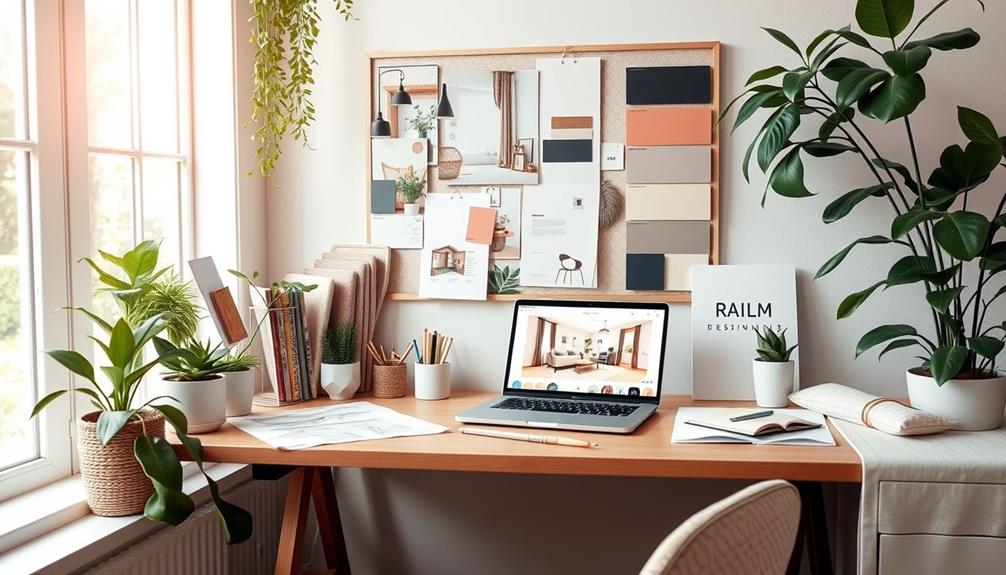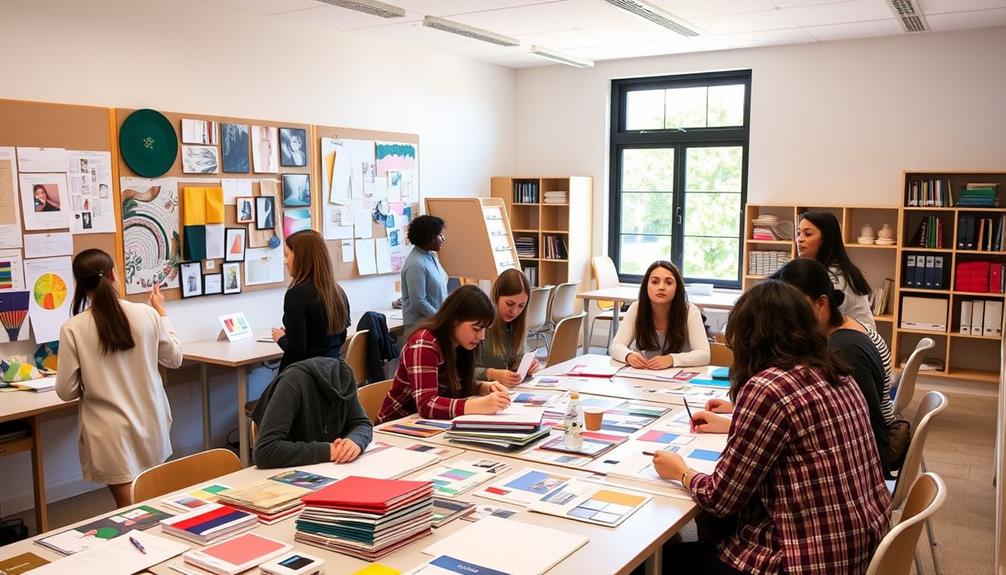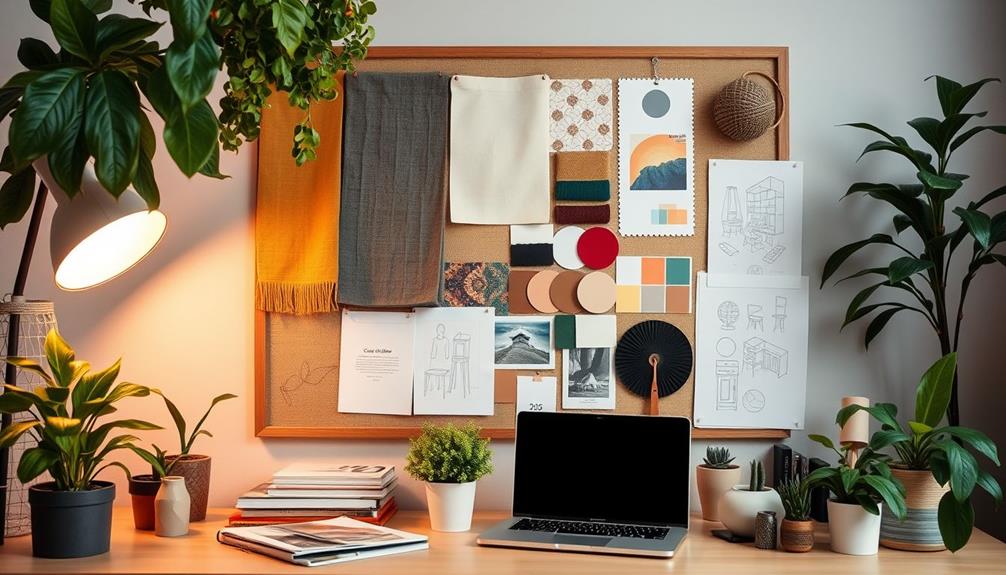You can break into interior design without experience by starting with education. Consider enrolling in a degree or certificate program to gain essential skills. Build your portfolio through personal projects or volunteer work. Practical experience, like internships or community events, helps you connect with the industry. Focus on mastering design software and improving your communication skills. Network actively at industry events to forge valuable connections. Tailor your job applications to highlight relevant skills and experiences. By following these steps, you'll position yourself for success in the interior design field and uncover even more strategies to enhance your journey. Seek mentorship from established professionals in the industry to gain valuable insights and guidance. Stay updated on current design trends and industry news to remain competitive in the field. Seek out additional resources and advice on interior design career tips to continue growing and developing your skills. By staying proactive and committed to your growth, you’ll set yourself up for a successful and fulfilling career in interior design.
Key Takeaways
- Pursue formal education or certificate programs to gain foundational knowledge and skills in interior design.
- Build a diverse portfolio by engaging in personal projects, volunteer work, and internships to showcase creativity.
- Enhance technical skills by mastering design software like AutoCAD and Adobe Creative Suite through online courses and workshops.
- Network within the industry by attending events, joining professional organizations, and leveraging social media for connections and job opportunities.
- Tailor applications and highlight transferable skills, ensuring to create a strong portfolio aligned with desired interior design roles.
Educational Pathways

When you're considering a career in interior design, choosing the right educational pathway is essential. You've got options! Pursuing an Associate's or Bachelor's degree in Interior Design gives you foundational knowledge in design principles and technical skills important for success in the industry.
These formal education programs often include hands-on training and workshops, enhancing your abilities in design software and client interaction.
If you're not ready for a full degree, certificate programs focusing on decorating can serve as an excellent alternative. They allow you to gain specific skills without the long-term commitment.
No matter which route you choose, continuous education is critical. Online courses, seminars, and industry workshops help you stay updated with the latest interior design trends, ensuring your skills remain relevant.
Lastly, consider building a robust portfolio through personal projects or volunteer work in design-related activities. This showcases your skills and creativity to potential employers and sets you apart in a competitive field.
Gaining Practical Experience

Gaining practical experience is essential for aspiring interior designers looking to stand out in a competitive field. One effective way to do this is by seeking internships or volunteer positions with established design firms or professionals. These opportunities provide hands-on experience and valuable industry exposure that can help you refine your design skills.
You can also engage in personal projects by redesigning your own space or assisting friends and family. This not only allows you to practice your skills but also helps you build a portfolio showcasing your work.
Attending workshops, seminars, or community events related to interior design is another great avenue. These gatherings enhance your knowledge while letting you connect with industry professionals who can offer insights.
Don't underestimate the power of online resources either. Leverage design courses and tutorials to learn about essential design principles and software tools used in the industry.
Developing Essential Skills

Building on your practical experience, developing key skills is fundamental for your growth as an interior designer. Start by familiarizing yourself with foundational interior design principles like color theory, space planning, and various design styles. You can easily find online courses or workshops that focus on these specific skills.
Additionally, understanding the principles of a Cottagecore Home Office can provide you with unique insights into creating serene and cozy spaces.
Next, enhance your technical skills by learning to use design software such as AutoCAD, SketchUp, and Adobe Creative Suite. Mastering these tools is essential for creating professional design presentations and renderings that impress clients.
Don't forget to nurture your creativity. Engage in personal design projects, whether it's redecorating your own space or volunteering to assist friends and family. Each project helps you refine your creative instincts.
Strong communication and customer service skills are also important. Practice active listening and engage in discussions about design preferences and project ideas. This will prepare you for successful client interactions.
Lastly, stay updated with industry trends by following design blogs, attending trade shows, and participating in online communities. This will broaden your knowledge and inspire your design journey.
Building Your Portfolio

Creating a compelling portfolio is vital for showcasing your skills and attracting potential clients or employers in the interior design industry. When building a successful professional portfolio, you should include a diverse range of projects to highlight your creativity and versatility.
Consider incorporating the following:
- Personal redesigns of your own space
- Volunteer work for community projects
- Mock designs for fictitious clients
- Before-and-after transformations of spaces
- Sketches and mood boards that illustrate your thought process
Utilizing high-quality photographs is key. Capture completed projects and provide before-and-after images to demonstrate your problem-solving abilities. This visual storytelling will speak volumes about your design skills.
Make your portfolio easily accessible by using digital platforms like Behance or your personal website. Confirm it's visually appealing and up-to-date.
Regularly update your portfolio with new projects, skills learned from courses or workshops, and any freelance work you undertake. This ongoing development is vital in securing interior design jobs and showcasing your growth in the field.
With a strong portfolio, you'll be well on your way to making a mark in the interior design industry.
Networking Strategies

To succeed in interior design, you need to connect with others in the field.
Attend industry events and join design communities to meet professionals who can share valuable insights and opportunities.
These connections can help you navigate your career path and build a strong network.
Attend Industry Events
Attending industry events can markedly boost your interior design career, as they provide invaluable opportunities to connect with established professionals and immerse yourself in the latest trends.
By actively participating in these events, you can enhance your networking skills and build relationships with design firms and influential figures in the field.
Here are some effective ways to make the most of these gatherings:
- Attend trade shows and design exhibitions to discover new products and innovations.
- Participate in workshops and seminars to sharpen your skills and meet potential mentors.
- Join professional organizations like the American Society of Interior Designers (ASID) for access to exclusive networking opportunities.
- Follow event announcements on social media platforms like Instagram and LinkedIn to stay updated and connect with other attendees.
- Volunteer for event planning committees or assist at trade shows to gain experience and build relationships with key players.
Join Design Communities
Building on the connections made at industry events, joining design communities can greatly enhance your professional journey in interior design. These communities, whether local organizations or online forums, provide valuable networking opportunities that connect you with established professionals who can offer guidance and mentorship.
Participating in design workshops and community events not only sharpens your skills but also helps you build relationships with fellow aspiring designers and industry veterans. Engaging with design communities on social media platforms like Instagram and Pinterest allows you to share your work, gain feedback, and discover potential collaborators.
Additionally, attending industry trade shows and expos, such as the Kitchen & Bath Industry Show (KBIS), exposes you to the latest trends while expanding your professional network. You can also consider volunteering for design-related projects with non-profits, giving you practical experience and showcasing your commitment to the field.
This not only benefits your portfolio but also helps you make meaningful connections within the design community. By actively participating in these communities, you'll take significant steps toward establishing yourself in the world of interior design.
Job Search Techniques

How can you effectively navigate the job market in interior design? Finding a job in interior design without prior experience might seem overwhelming, but with the right strategies, you can land that entry-level position. Here are some techniques to reflect upon:
- Utilize job boards like Indeed and Glassdoor for entry-level roles such as Interior Design Assistant or internships.
- Network within the community by attending industry events, workshops, and local meetups to build valuable connections.
- Tailor your resume and cover letter for each application, highlighting transferable skills like creativity and project management.
- Volunteer for community projects or offer design services for free or at a reduced rate to enhance your portfolio and gain practical experience.
- Leverage social media platforms like Instagram and Pinterest to showcase your personal design projects and engage with potential employers.
Preparing Your Application

When preparing your application for an interior design position, it's essential to highlight transferable skills from past experiences, even if they're outside the design field.
You'll want to craft a strong portfolio that showcases your best work and aligns with the role you're applying for.
Don't forget to tailor your resume to match the job description, demonstrating your attention to detail and genuine interest in the position.
Highlight Transferable Skills
Many aspiring interior designers overlook the importance of highlighting transferable skills in their applications. By effectively showcasing these skills, you can greatly enhance your resume and cover letter. Here are some key areas to focus on:
- Project Management Skills: Emphasize your ability to oversee timelines and budgets, which is vital in interior design projects. Additionally, consider how your experience with stylish wall clocks can translate into managing design elements and making certain they fit within a cohesive plan.
- Customer Service Experience: Strong interpersonal skills are essential for understanding client needs and building lasting relationships. Your ability to communicate effectively can also aid in discussing design choices like selecting pendant lights for various spaces.
- Creative Endeavors: Include personal design projects or volunteer work to demonstrate your aesthetic sensibilities and creative problem-solving abilities. Showcasing how you've created an extraordinary atmosphere in your own home can be a powerful indication of your design skills.
- Technical Proficiency: Mention any relevant software tools you've learned, like CAD or Photoshop, as technical skills are increasingly important.
- Tailored Application: Confirm your resume and cover letter reflect how your previous experiences align with the responsibilities of an interior designer.
Craft a Strong Portfolio
Crafting a strong portfolio is essential for showcasing your skills and creativity as an aspiring interior designer. Start by creating a diverse portfolio that includes a variety of interior design projects.
Consider adding personal home redesigns, mood boards, and sketches to demonstrate your range of design styles and abilities.
Use high-quality photographs and detailed descriptions for each project to highlight your design process, choices, and the results achieved. Incorporating before-and-after images will effectively demonstrate your design skills and the impact of your work on a space.
To increase accessibility and visibility to potential employers and clients, consider creating an online portfolio using platforms like Behance or setting up a personal website. This can help you reach a wider audience and showcase your work in a professional format.
Regularly update your portfolio with new projects and skills to keep it current and reflective of your evolving design capabilities.
Tailor Your Resume
Tailoring your resume to match each job application can greatly enhance your chances of landing an interview in the competitive field of interior design.
To make your resume stand out, focus on aligning your skills and experience with the specific job requirements. Here are some key elements to include:
- Highlight transferable skills: Emphasize project management, communication, and customer service from previous roles.
- Customize for each application: Align your experiences with the job description, showcasing relevant skills and design-related projects.
- Education and training: List any interior design courses, certifications, or workshops, even if informal or online.
- Showcase practical experience: Include personal projects, volunteering, or assisting friends and family with their design needs, adding before-and-after photos if possible.
- Pay attention to format: Guarantee your resume is visually appealing and easy to read, reflecting your understanding of design aesthetics.
Interview Best Practices

Nail your interior design interview by showcasing both your creativity and professionalism. Arrive at least 10-15 minutes early—punctuality reflects your commitment and is highly valued in the design industry.
Dress to impress; choose attire that mirrors your personal style while aligning with the firm's culture. This balance demonstrates your creativity and professionalism.
Prepare a list of thoughtful questions about the firm's design philosophy, recent projects, and paths for growth. This shows that you're engaged and genuinely interested in becoming part of their team.
When discussing your skills, focus on how your background—even if not directly in design—can contribute to the role, particularly in project management, organization, and communication.
After the interview, don't forget to send a follow-up email within 24 hours. Thanking the interviewer not only reiterates your enthusiasm for the position but also leaves a lasting positive impression.
Continuing Education Opportunities

Continuing education in interior design is essential for anyone looking to stay relevant in this ever-evolving field. By pursuing various educational opportunities, you can enhance your skills, gain new knowledge, and keep up with the latest trends.
Here are some options to reflect upon:
- Community colleges offer affordable certificate programs that provide foundational knowledge without requiring prior experience.
- Online platforms like Coursera and Udemy feature extensive courses on design principles, software training, and specific techniques that you can access anytime.
- Attend workshops and seminars hosted by professional organizations such as the American Society of Interior Designers (ASID) to enhance your knowledge and network with industry professionals.
- Many institutions offer continuing education units (CEUs) through specialized courses focusing on current design trends and technologies, which are often needed for maintaining professional certifications.
- Engaging in local design meetups or online forums allows you to learn from experienced designers, gaining insights into best practices and industry standards.
Conclusion
Breaking into interior design without experience might seem intimidating, but it's entirely possible with determination and the right strategies. Take Jane, for instance—she started by shadowing a local designer and quickly developed her skills. By building a strong portfolio and networking at industry events, she landed her first job in just six months. Embrace every opportunity, and remember that passion and persistence can open doors in this vibrant field. You've got this!








